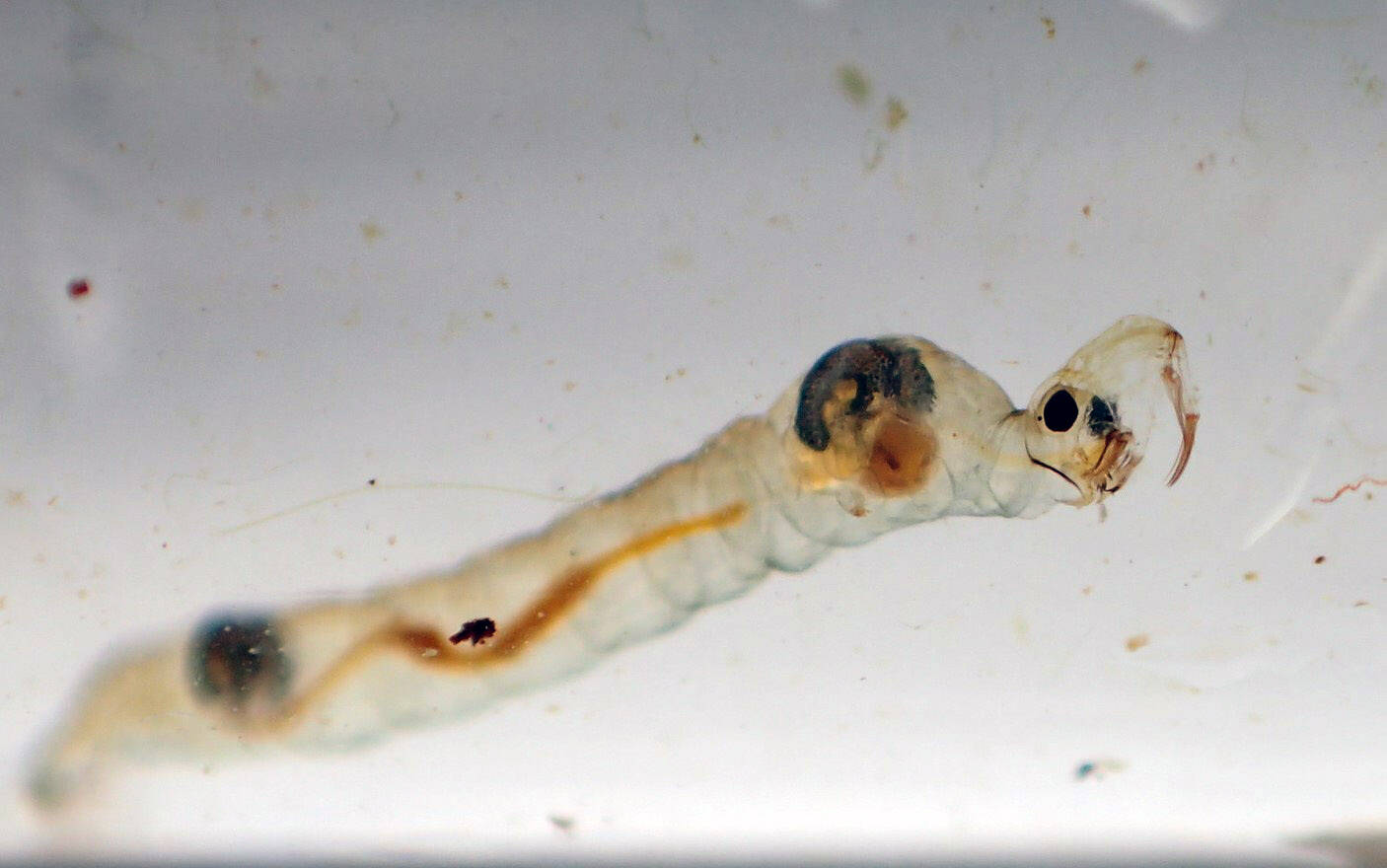As we at the Kenai National Wildlife Refuge seek to know about the living things that call this place home, we come across many interesting names of animals, plants and other things. The names themselves have much to say, describing what their owners look like, how they behave or where they live. Other names honor certain people, memorializing human relationships.
Take the black-bristled logsitter, for example, a name that highlights a distinguishing feature (coarse, black hairs) and a behavior (spending time on logs). Doesn’t that name make you wonder what kind of thing it is?
How about Eschscholtz’s little nightmare, named after German naturalist Johann Friedrich von Eschscholtz, who accompanied Otto von Kotzebue on his expeditions to Alaska between 1815 and 1826, but leaves us wondering what is it and should I be concerned?
Here I want to share a selection of these names in hopes that some of them catch your attention, causing you to wonder about the organisms they describe. In doing so, you might become better acquainted with the surprising variety found on the Kenai and consider that each kind of living thing out there has its own unique story.
Some of these names sound like they came right out of a Dr. Seuss book, so fire up your imagination as you read aloud these names: ambiguous bran lichen, black-footed globetail, cold crabeye lichen, Colorado running crab spider, counterpart erudite money spider, Crosby’s immaculate cobweaver, dark-barred twin-spot carpet, deformed cup lichen, dirt-colored seed bug, dog sick fungus, Donn’s dry rock moss, dwarf mountain fleabane, electrified cat’s tail moss, eggyolk lichen, evanescent fungus gnat, glacier ice worm, hitchhiking hammock sheetweaver, intertidal pseudoscorpion, lesser rattlesnake plantain, long-bodied cellar spider, moose fly and ragbag.
You could get the wrong idea from some names. For example, the mountain jumping spider cannot jump over mountains. The bank sac spider neither lives in a sack in a bank nor does it sack banks. Dog sick fungus does not make dogs sick; it looks like dog vomit.
Their names can help us know about tricky look-alikes, especially when you are harvesting food. The spring-blooming flowers of false huckleberries resemble those of blueberries and huckleberries. These flowers have deceived prospective gatherers who returned later in the year at berry-picking time, only to find small, hard, inedible fruits.
Don’t you be fooled by other tricky-descriptive names like the deceiving frit fly, green false hellebore, false morel, false spirea, false toadflax (also called red-fruited bastard toadflax), or scentless false mayweed.
You might be a little concerned about your next walk in the woods if you anticipated that you could bump into things with scary names like alpine enchanter’s nightshade, blood lichen, blood-sucking snipe fly, deathstring orbweaver, deathcamas, devil’s club, ghost midge, Ochlerotatus excrucians (which basically means torturer mosquito), treacherous swamp fly, or witch’s butter.
While scientific names serve a purpose, they can sound like an excerpt from a wizard’s book of incantations.
Try to recite these Latin names clearly: Acarospora smaragdula, Amphorophora agathonica, Barbilophozia kunzeana, Calvia quatuordecimguttata, Chrysomyxa woroninii, Euchoplopsyllus glacialis, Eurhynchium pulchellum, Gnathacmaeops pratensis, Kaltenbachiola rachiphaga, Kusnezoviella macleani, Megaphthalmoides unilineatus, Ochrolechia szatalaensis, Oncorhynchus tshawytscha, Phaeocalicium compressulum, Placobdella kwetlumye, Plectrophenax nivalis, Pseudoscleropodium purum, Pseudotaxiphyllum elegans, Psilometriocnemus triannulatus, Quedionuchus plagiatus, Rhopalopterum soror, Rhytidiadelphus loreus, Rinodina mniaraea, Sarmenthypnum sarmentosum, Scheuchzeria palustris, Schoenoplectus tabernaemontani, Xenochironomus xenolabis, and Ypsolopha senex.
Don’t those just roll off of your tongue?
We can also make some generalizations based on names. For example, we have plenty of hairy things: bristly haircap, common hair moss, dwarf hairy-legged money spider, forked hair-lichen, goat’s beard, hairy butterwort, hairy cinquefoil, hairy-eyed flower fly, hairy purslane speedwell, hairy rockcress, Hairy Woodpecker, holarctic bristleside, Lapland beard lichen, mountain hairgrass, narrow-leaved hawksbeard, woolly hawkweed, tall woolly-heads, woollyfruit sedge, woolly geranium, woolly lousewort.
You can also tell that we live up north from these high latitude names: arctic alpine fleabane, arctic aster, arctic bluegrass, arctic Brodoa lichen, arctic char, arctic cinquefoil, arctic cottongrass, arctic Dactylina lichen, arctic daisy, arctic dock, arctic fritillary, arctic grayling, arctic kidney lichen, arctic lupine, arctic raspberry, arctic rim lichen, arctic skipper, arctic starflower, arctic stitchwort, arctic sweet coltsfoot, Arctic Tern and arctic wheatgrass.
Don’t forget Boletina arctica, boreal bluet, boreal bog sedge, boreal carnation, Boreal Chickadee, boreal black-banded cobweaver, boreal cobweb weaver, boreal cup lichen, boreal Draba, boreal long-jawed orbweaver, boreal orbweaver, Boreal Owl, boreal sac spider, boreal top, Dolichovespula arctica, Glyceria borealis and Linnaea borealis.
Then there’s northern asphodel, northern blowfly, northern blue, northern bluegrass, northern bluet, northern bog lemming, northern bog sedge, northern bugleweed, northern bur-reed, northern dandelion, Northern Flicker, northern golden saxifrage, Northern Goshawk, northern green rush, northern groundcone, Northern Harrier, Northern Hawk Owl, northern hollyfern, northern Jacob’s-ladder, northern Labrador tea, Northern Pintail, northern reedgrass, northern river otter, Northern Saw-whet Owl, northern sedge, Northern Shoveler, Northern Shrike, northern singlespike sedge, northern starwort, Northern Wheatear, Petridiobius arcticus, Pityohyphantes subarcticus, Polixenes arctic and subarctic darner.
As for the black-bristled logsitter mentioned at the beginning of the article, it is a specialized flower fly whose larvae develop under the bark of aspen logs. The adults can be found on logs or feeding on flowers.
Eschscholtz’s little nightmare is a rare, diminutive mustard that has not yet been found on Kenai National Wildlife Refuge. However, it does live nearby at Palmer Creek on Chugach National Forest. I have not found out how it got its name, but I am sure there is a story there.
I hope sharing this selection of names of the over 2,000 species known on or near the refuge paints a picture of the many fascinating creatures and plants that share the Kenai Peninsula with us.
Matt Bowser serves as a Fish and Wildlife Biologist at Kenai National Wildlife Refuge. Michelle Ostrowski also contributed to this article. Find more Refuge Notebook articles (1999–present) at https://www.fws.gov/refuge/

